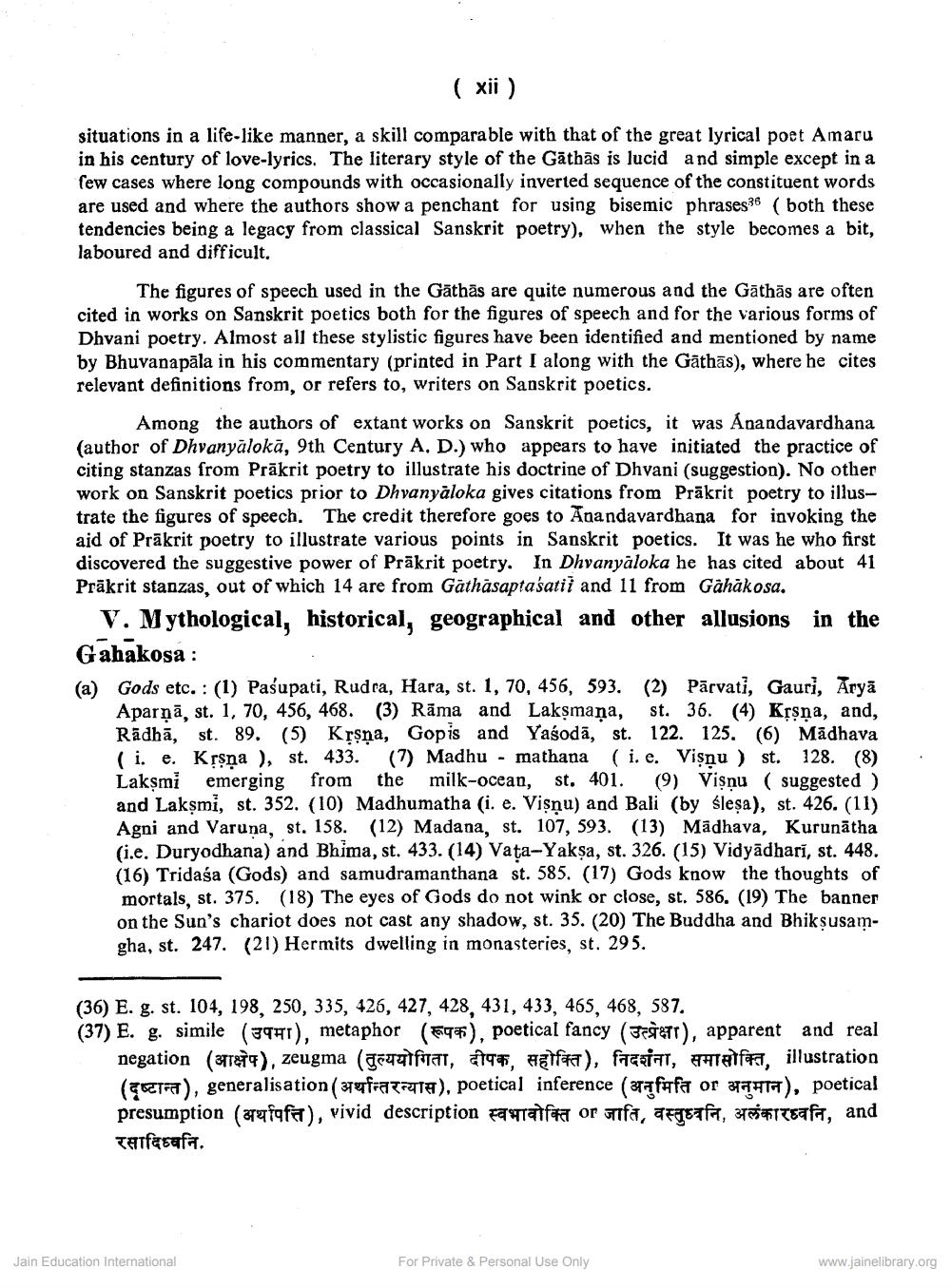________________
(xii)
situations in a life-like manner, a skill comparable with that of the great lyrical poet Amaru in his century of love-lyrics. The literary style of the Gathas is lucid and simple except in a few cases where long compounds with occasionally inverted sequence of the constituent words are used and where the authors show a penchant for using bisemic phrases (both these tendencies being a legacy from classical Sanskrit poetry), when the style becomes a bit, laboured and difficult,
The figures of speech used in the Gathās are quite numerous and the Gāthās are often cited in works on Sanskrit poetics both for the figures of speech and for the various forms of Dhvani poetry. Almost all these stylistic figures have been identified and mentioned by name by Bhuvanapala in his commentary (printed in Part I along with the Gathās), where he cites relevant definitions from, or refers to, writers on Sanskrit poetics.
Among the authors of extant works on Sanskrit poetics, it was Anandavardhana (author of Dhvanyalokā, 9th Century A. D.) who appears to have initiated the practice of citing stanzas from Präkrit poetry to illustrate his doctrine of Dhvani (suggestion). No other work on Sanskrit poetics prior to Dhvanyaloka gives citations from Prakrit poetry to illustrate the figures of speech. The credit therefore goes to Anandavardhana for invoking the aid of Prakrit poetry to illustrate various points in Sanskrit poetics. It was he who first discovered the suggestive power of Prakrit poetry. In Dhvanyaloka he has cited about 41 Prakrit stanzas, out of which 14 are from Gathàsaptasatii and 11 from Gahakosa.
V. Mythological, historical, geographical and other allusions in the Gahakosa:
(a) Gods etc. (1) Pasupati, Rudra, Hara, st. 1, 70, 456, 593. (2) Parvati, Gauri, Arya Aparņā, st. 1, 70, 456, 468. (3) Rama and Lakṣmaṇa, st. 36. (4) Krsna, and, Radha, st. 89. (5) Krsna, Gopis and Yasoda, st. 122. 125. (6) Madhava (ie. Krsna ), st. 433. (7) Madhu - mathana (i. e. Visņu) st. 128. (8)
Laksmi emerging from the milk-ocean, st. 401. (9) Visņu (suggested) and Laksmi, st. 352. (10) Madhumatha (i. e. Visņu) and Bali (by śleṣa), st. 426. (11) Agni and Varuna, st. 158. (12) Madana, st. 107, 593. (13) Madhava, Kurunatha (i.e. Duryodhana) and Bhima, st. 433. (14) Vaṭa-Yakṣa, st. 326. (15) Vidyadhari, st. 448. (16) Tridaśa (Gods) and samudramanthana st. 585. (17) Gods know the thoughts of mortals, st. 375. (18) The eyes of Gods do not wink or close, st. 586, (19) The banner on the Sun's chariot does not cast any shadow, st. 35. (20) The Buddha and Bhiksusamgha, st. 247. (21) Hermits dwelling in monasteries, st. 295.
(36) E. g. st. 104, 198, 250, 335, 426, 427, 428, 431, 433, 465, 468, 587. (37) E. g. simile (a), metaphor (), poetical fancy (err), apparent and real negation (आक्षेप), zeugma (तुल्ययोगिता, दीपक, सहोक्ति), निदर्शना, समासोक्ति, illustration ( दृष्टान्त), generalisation ( अर्थान्तरन्यास) poetical inference (अनुमिति or अनुमान) poetical presumption (अर्थापत्ति), vivid description स्वभावोक्ति or जाति, वस्तुध्वनि, अलंकारध्वनि, and zerfacefa.
Jain Education International
For Private & Personal Use Only
www.jainelibrary.org




